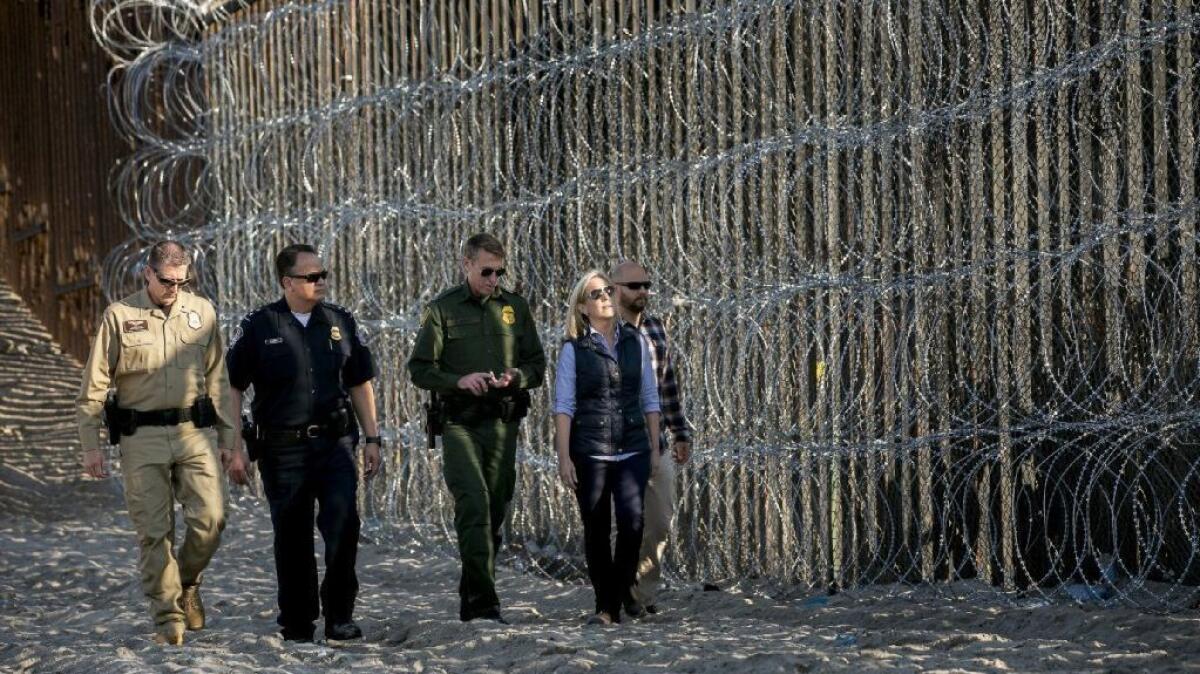In San Diego visit, Homeland Security secretary calls caravan a ‘crisis ... on the other side of this wall’

- Share via
Reporting from SAN DIEGO — Standing on a beach Tuesday near the concertina wire-topped fence that divides the U.S. and Mexico, Homeland Security Secretary Kirstjen Nielsen fought back against assertions that Central American migrants bound for the United States as part of a caravan were docile women and children fleeing violence.
Instead, saying she wanted to “set the record straight,” she said most of the thousands of caravan members are adult or teenage males leaving their home countries for economic reasons or to be reunited with family members living in the U.S.
“Wanting a job is not a basis for asylum under U.S. law,” Nielsen told reporters at Border Field State Park in Imperial Beach. “Wanting to be reunited with your family is not a basis for asylum under U.S. law. Wanting to live in the U.S. — not a basis for asylum under U.S. law.”
She said more than 500 criminals, including documented gang members, have been identified among the caravan, but she would not say how the alleged criminals were identified.
“Let me be clear,” she added, “the caravan does not give one a special right to enter this country. Members of the caravan will wait in the back of the line of those already waiting to be processed at our ports of entry.”
Nielsen’s remarks came after she got a glimpse of the concertina wire that crews recently wrapped around the metal fence dividing Imperial Beach and Tijuana — the same site where a week earlier the first arriving caravan members gathered to celebrate, with some boldly climbing on top in triumph.
Guided by Rodney Scott, chief Border Patrol agent for the San Diego sector, Nielsen walked along the fence as onlookers gathered on both sides of the border.
Just an hour earlier, as members of the news media awaited Nielsen’s arrival, a man swam from Mexico into the U.S. He was detained and taken to a station to be processed, officials said. It was unclear whether the man was a member of the caravan.
The secretary’s sharp assessment of the migrants counters criticism that the Trump administration is exaggerating the threat they pose and going overboard by deploying troops to aid border authorities.
Nielsen said there are more than 6,200 migrants “camped out” in Tijuana and more than 3,000 caravan members in Mexicali, 110 miles to the east. Combined with other groups still traveling through Mexico, officials expect as many as 10,000 migrants to arrive at the border, she said.
That number starkly differs from what the Mexican Consulate has reported: 2,610 in Tijuana, 2,995 in Mexicali and an additional 2,600 or so en route farther south in Mexico. Tijuana officials have confirmed that most of the migrants in the city are adult males.
“The crisis is real, and it is just on the other side of this wall,” Nielsen told reporters.
Nielsen said that based on “historic trends, intel and open-source reporting,” officials anticipate that most caravan members will make “frivolous or unsubstantiated claims of asylum.”
She said only 9% of migrants from the so-called Northern Triangle countries of Central America — Guatemala, Honduras and El Salvador — were determined to be eligible for asylum by a federal immigration judge in 2017.
“To fuel the sympathetic narrative we continue to see repeated in U.S. media, we know that organizers of the caravan have been pushing women and children and others to the front of the caravan in hopes law enforcement will not engage them,” Nielsen said.
She blamed the influx of migrants, which she described as an “unprecedented crisis,” on what she characterized as loopholes created by “poorly drafted” federal laws and a “deeply flawed” ruling by the 9th U.S. Circuit Court of Appeals that bans the detention and immediate deportations of minors and families.
She also said she was “deeply disappointed and troubled” by a federal judge’s emergency ruling Monday against President Trump’s attempt to deny migrants who cross the border illegally the chance to seek asylum.
Nielsen said the government plans to appeal that order, but in the meantime, the Trump administration plans to adhere to the ruling.
“Our weak immigration laws have encouraged caravans to try to break our immigration laws,” she said, calling on on Congress to close the loopholes.
Meanwhile, troops are continuing to work along the Southwest border, with particular focus in California, on fortifying the fence to prevent illegal crossings.
Of the 5,600 troops, about 1,300 are in California, most of them Marines from Camp Pendleton, Miramar and Twentynine Palms.
Nielsen pushed back on reports that the troops might be pulling out early, saying she’d spoken with Defense Secretary James N. Mattis.
“I have no doubt they will continue to partner with us in this mission until it is resolved,” she said Tuesday. An end date of Dec. 15 for the military mission had been set previously.
U.S. Northern Command said Tuesday: “We may shift some forces to other areas of the border to engineering support missions in California and other areas. No specific timeline for redeployment has been determined.”
Along the border fence, the ramping up of operations was unmistakable.
Near inspection booths at the San Ysidro Port of Entry, about two dozen Customs and Border Protection officers in riot gear lined up for crowd control drills. The officers were brought in from south Texas within the last week to reinforce staffing, CBP said.
They join 250 Border Patrol agents who arrived Tuesday from the northern U.S. border to supplement manpower.
Between nearly each vehicle lane on the approach to the U.S., concrete road barriers topped with three levels of concertina wire have been staged — the work of visiting troops. Should the vehicle lanes need to be closed quickly, the barriers can be swung into place with military forklifts to block traffic.
That’s exactly what happened early Monday as border authorities said they received information that a group of migrants was assembling near the vehicle lanes to rush into the U.S. The military quickly responded about 3 a.m. and closed most of the lanes, resulting in major delays for travelers. A rushing of the border did not occur.
Meanwhile at the Otay Mesa Port of Entry on Tuesday, Marine engineers were busy with the tedious work of topping the border fence with roll after roll of concertina wire, which is designed more to snag clothing than mutilate. These are the Marines who dig ditches, clear fields and build perimeters to set up forward operating bases for their fellow troops to securely inhabit.
The work begins by measuring and cutting metal stakes, then welding two together into a sort of cross. The cross is then welded onto the top of the border fence, adding about 3 feet of height to the already new 18-foot-high fencing being erected along the San Diego border.
Other troops then come behind the welders, raised on cherry picker platforms, unspooling lengths of wire onto the stakes in a sort of pyramid stack — two rows on each side of the fence and one on top, bound together with barbed wire.
Other portions of the 14-mile border fence in San Diego require more hardening, either due to patches caused by ongoing construction or to aging, lower fencing.
Military police from the Army patrol were close by as armed protection should the Marines run into trouble as they work. MPs have come from Joint Base Lewis-McChord in Washington state and Ft. Bliss, Texas.
The units have typically been working shifts dictated by the sunlight, except for the predawn emergency shutdown Monday.
Although many of these Marines live close enough — either on or off base — to go home each night, they are camped out together as a true special purpose Marine air-ground task force. Logistics units are included with the deployment, providing hot showers and meals, and military helicopters are on standby to transport men and women as needed.
“It’s all about that mindset. To be able to do this you have to be able to focus on that mission,” said Marine Gunnery Sgt. Edward Guevara, a military spokesman stationed at Camp Pendleton. Going back home to barracks, or to family obligations each night, would be distracting, he said.
“It’s essentially the same thing you’d see if they were deployed anywhere else,” Guevara said.
The location of their base camp has not been made public, but it is close to the border for a quick response if necessary.
Also Tuesday, the Border Patrol in El Centro met with members of the Honduran Consulate — which is hastily being set up south of the border — to familiarize them with the process if one of their citizens is arrested on suspicion of crossing the border illegally.
“We appreciate their visit,” Customs and Border Protection tweeted.
Hernandez and Davis write for the San Diego Union-Tribune.
More to Read
Sign up for Essential California
The most important California stories and recommendations in your inbox every morning.
You may occasionally receive promotional content from the Los Angeles Times.















